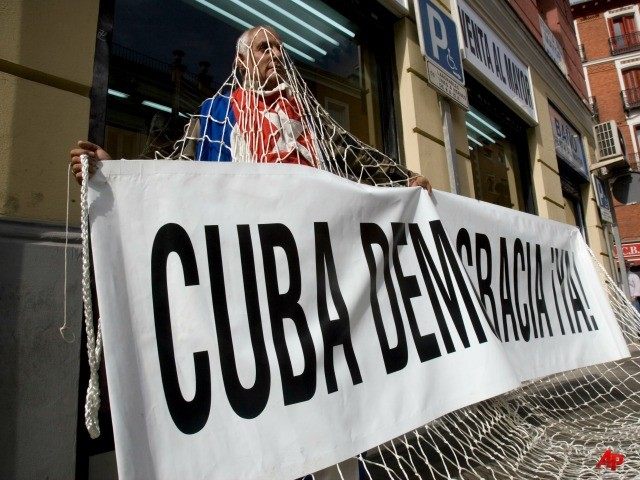The first talks the Obama administration held with Havana was in July of 2009 in New York City, when CubaNews reported the U.S. is “likely to be anxious to ask Cuban officials for help in curbing a rise in undocumented immigration from Cuba.”
According to reports, a statement sent from Havana after the talks stated the communist nation’s long held opposition to the policy, saying:
“Legal, safe and orderly immigration from Cuba cannot be achieved while the Cuban Adjustment Act and the wet foot-dry foot policy exist in the United States, both of which encourage illegal exits and human smuggling by providing differentiated treatment to Cubans who reach U.S. territory illegally.”
The White House did not discuss with Cuban officials about any plans to change the Cuban Adjustment Act, Breitbart News learned on Thursday. Officials wouldn’t address the issue during the meeting relating to “normalizing” diplomatic relations with the island nation, because the White House wanted to discuss the policy with a broader group of officials on its side.
In his remarks on Cuba Wednesday, President Barack Obama noted that he plans to “reestablish diplomatic relations” with the communist Castro-led nation “that have been severed since January of 1961.”
“Going forward, the United States will reestablish an embassy in Havana, and high-ranking officials will visit Cuba. Where we can advance shared interests, we will -– on issues like health, migration, counterterrorism, drug trafficking and disaster response,” Obama said.
“They could treat Cubans that are caught by the border patrol on the Mexican border differently. There’s actually an increasing flow of Cubans through Central America and through Mexico to cross the Rio Grande. That’s like the new growth area for Cuban illegal immigration into the United States,” Mark Krikorian, President of the Center for Immigration Studies, told Breitbart News.
“While conceivably they might change the policy toward Cubans on the Rio Grande, which, basically, they’re treated the same as those who wash up in Miami, I don’t think they can do that without changing the policy for every other non-Mexican illegal who sneaks through Mexico and tries to claim asylum. That’s something they won’t do–even though I think they should, they won’t.”
The Cuban Adjustment Act of 1966 allows for Cuban immigrants to apply for legal residency in the United States after one year in the country. Cuban immigrants were often picked up on the high seas by the U.S. Coast Guard and brought to American shores. From there, these individuals could claim asylum from the oppressive communist regime.
Hundreds of thousands of Cubans entered the U.S. from the early 1960s to the early 1980s. In an effort to hit back at the U.S. policy, in 1980 Castro released criminals and individuals with mental illnesses from his prisons and sent them on boats to the United States.
By 1995 the Clinton administration had changed the Cuban Adjustment Act, so any Cuban migrant who was picked up on the high seas or near the U.S. border was returned to Cuba or a third country. However, if a Cuban migrant made it to U.S. dry land without being intercepted by authorities, he or she would be eligible for expedited “legal permanent resident” status and eventually U.S. citizenship. The policy became known as the “Wet Foot, Dry Foot” policy.
“The wet foot, dry foot part of it is a Clinton innovation, because it used to be that any Cuban that was found for any reason, even in international waters, was automatically brought to the United States and allowed to stay,” said Krikorian.
“So what Clinton did was just say, ‘Well the Cuban Adjustment Act is here but it doesn’t say whether here is the high sea or on the beach, so we’re interpreting this as, you have to actually be in the United States before its relevant.”
Krikorian continued: “Number one, that’s more leeway for change, so Obama doesn’t want to send any illegal immigrants back to any place—even countries that aren’t run by gangsters, so I’m not sure it would make any difference. On the other hand, the logic of the president’s argument is that Cuba should no longer enjoy its own distinct immigration policy different from any other country in the world.”
During the 2009 New York meeting, CubaNews reported, State Department spokeswoman Heide Bronke said, “The purpose of these talks is to have safe, legal and orderly migration.”
Peter Hakim, president of the Inter-American Dialogue, noted that the Obama administration opened up talks about Cuba’s concerns relating to Cuban U.S. migration again during the 2009 meeting, telling CubaNews at the time, “The talks are like low-hanging fruit. They don’t involve high political costs and may have a few benefits.”
However, the current Obama immigration policy appears to contradict what Cuba is asking for. In July of this year, the White House requested about $2 billion to provide shelter for illegal immigrants as well as U.S. attorneys and asylum advocates to provide counsel for some immigrants on asylum applications.
“There are cases of even Mexicans near the border area who are fleeing drug gangs. That’s a real thing—like a newspaper editor in a northern town, but the threats don’t apply to [asylum] because there’s all kinds of people in the north who have fled to Mexico City to get away from the drug gangs,” Krikorian noted. “Asylum is for people who are fleeing persecution and cannot find any refuge in their own country and have passed through any other country where they could have sought refuge.”

COMMENTS
Please let us know if you're having issues with commenting.